Explainer
- Explainer
- US Votes 2024
Trump joked he would be dictator for a day. But could it happen?
They can pardon a turkey and order a nuclear strike – but can a sitting US president sweep away all checks and balances on power?
By Jackson Graham and Angus Holland
When, last December, Donald Trump said that if he won the presidency again he would act like a “dictator” for a day, nobody was sure whether or not he was serious. He later said he was joking but when asked if he thought his comments could scare people, he replied, “I think a lot of people like it.”
Two weeks out from the US presidential election, Trump’s former White House chief of staff, retired general John Kelly, stoked the “dictator” fire once again, saying that Trump fitted “into the general definition of fascist” and that he “certainly prefers the dictator approach to government”. Indeed, says John Hart, an emeritus professor of American politics and former head of department at ANU, in his first time in office, “Trump was fairly committed in his presidency to pushing the boundaries of executive power as far as he possibly could.” Which raises the question: what kind of leader will he be this time around?
Trump will certainly have at his disposal a range of special powers that are not necessarily well known, ranging from pardoning turkeys to ordering up nuclear strikes. In certain circumstances, particularly national emergencies, the president can act unilaterally. What this means, says US constitutional law professor Laurence Tribe, is that “the American president is the most powerful person on this planet, and when that person is not answerable to the people, the powers that he has are more than ample for him to essentially rule”.
So, what authority does the US president have? And how have presidents used their special powers in the past?
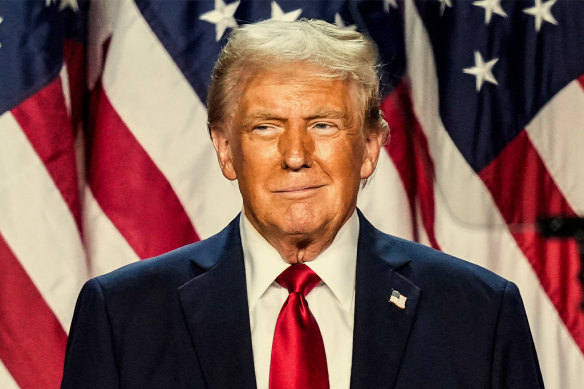
Donald Trump on election night in Florida. Credit: AP, digitally tinted
How has Trump said he would use presidential powers?
Trump has repeatedly said that once returned to office, he would, for a start, pardon at least some of the 1100 people who were sentenced for their actions in storming the Capitol Building on January 6, 2021, in an effort to overturn the 2020 election result. And he would have the power to do so. “I am inclined to pardon many of them [rioters]. I can’t say for every single one because a couple of them, probably they got out of control,” Trump said in 2023. In July, he repeated his promise, telling journalists: “Oh, absolutely I would. If they’re innocent, I would pardon them … they were convicted by a very tough system.”
A key question of a second Trump presidency would be whether he could also pardon himself for federal crimes for which he had been convicted. He has been charged over his involvement in attempts to overturn the 2020 election and for mishandling classified documents. Whether a president could pardon themselves for federal offences has never been tested legally. Says John Hart, “If Trump comes into office and pardons himself, there’s absolutely no way of anticipating how the courts would react.”
‘I will … put these vicious and bloodthirsty criminals in jail, then kick them the hell out of our country as fast as possible.’
What Trump has promised, however, is to fire the special prosecutor who has charged him, Jack Smith. “I would fire him within two seconds,” Trump told a radio host. “He’ll be one of the first things addressed.” Note, however, that the presidential pardon power doesn’t extend to cases tried in state courts, such as the conviction Trump received in New York for falsifying business records to cover up an affair with the adult-film actress Stormy Daniels – for which he is still awaiting sentencing – and the charges he is facing in Georgia over attempts to subvert the 2020 election result. If Trump were to receive a prison sentence, there is no constitutional provision that would disqualify him from being president or, indeed, from continuing to act as president from behind bars.
Trump has also said he intends to use local law enforcement and the National Guard to deport millions of undocumented migrants. “On day one, I will launch the largest deportation program in American history to get the criminals out,” he told a rally in New York in October. “I will rescue every city and town that has been invaded and conquered, and we will put these vicious and bloodthirsty criminals in jail, then kick them the hell out of our country as fast as possible.”
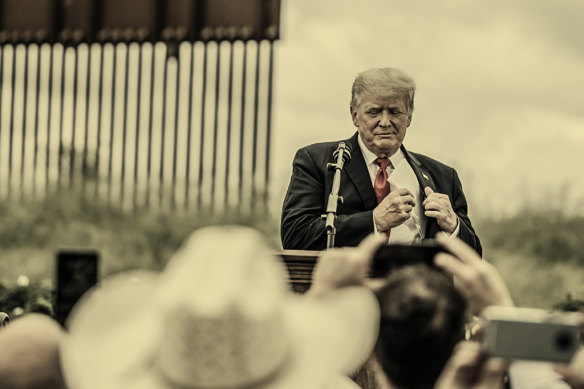
Trump vowed to “pass critical reforms making every executive branch employee fireable by the president of the United States”.Credit: GETTY IMAGES, DIGITALLY TINTED
He hasn’t ruled out using the military to do so, even though US law generally prevents presidents from using troops as domestic police. According to NPR, Trump has said he would invoke the Alien Enemies Act of 1798, which allows the president to detain and deport non-citizens from an enemy nation during wartime, and has considered invoking the Insurrection Act to deploy troops to the southwest border.
“I can see myself using the National Guard and, if necessary, I’d have to go a step further,” Trump has said. His campaign also reportedly has plans to construct camps to detain undocumented migrants, according to The New York Times. “Trump will unleash the vast arsenal of federal powers to implement the most spectacular migration crackdown,” Stephen Miller, a former senior adviser to Trump, told the outlet.
In April, Trump also said that, depending on the situation, he would fire a US attorney-general who failed to follow an order to prosecute someone. This has led critics to fear he could target political opponents (something Trump already claims is happening to him through the four criminal cases he faces).
The custom of the attorney-general acting independently of the president evolved after the Watergate scandal of 1972, notes Alan Rozenshtein, a University of Minnesota law professor. “The idea that the president does not interfere with the law enforcement decisions of the Department of Justice is purely a matter of custom and norm,” he says. “There’s no basis in law.”
At a campaign rally in 2022, meanwhile, Trump vowed to “pass critical reforms making every executive branch employee fireable by the president of the United States” – a public service made up of more than 4 million people. He has previous form: at the end of his presidency, Trump used an executive order to introduce a classification for public servants that would make them easier for him to fire. Just days after his inauguration, Biden repealed the move with his own executive order, and has introduced rules to make it harder to reclassify public servants.
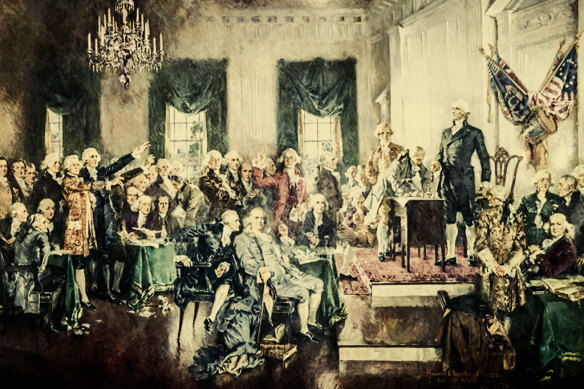
The signing of the US Constitution with George Washington, Benjamin Franklin, and Thomas Jefferson at the Constitutional Convention of 1787.Credit: Oil painting on canvas by Howard Chandler Christy, 1940. DIGITALLY TINTED
Why does the president have special powers?
Executive powers date back to the beginnings of the US as a nation in 1776, as it figured out how to differently govern what had been a British colony. After some trial-and-error constitution writing, “They did it by creating a president in a separate branch of government that had independent checks and balances by the other branches of government,” says John Hart. The other branches include the Supreme Court and Congress, which effectively hold each other and the president to account.
But, they wondered, how much power should the president have? John Adams, the first vice president, suggested the president should be known as “his elective majesty”, “his mightiness”, and even “his highness, the president of the United States of America and the protector of their liberties”.
George Washington was content with the simpler title “president of the United States”. However, the Constitution remained vague on how much latitude the position should be granted. Consequently, the ways in which presidential special powers – things they can do without the approval of Congress – have multiplied over the decades.
Let’s start with the presidential pardon. This includes the power to grant reprieves and pardons for offences against the US (federal crimes, not offences committed in particular states, which accounts for the bulk of everyday crime). The first presidential pardon in 1795 saved two men convicted of treason. Pardons redeemed two pirates who helped defend New Orleans against a British invasion, and more than a century later, an owner of the New York Yankees who had been found to have contributed illegal campaign funds to Richard Nixon. Bill Clinton famously pardoned his half-brother from a drug conviction.
By definition, an emergency is something you really can’t pin down and define in advance.
Lawrence Tribe
Presidential emergency powers are broader, kicking in once an “emergency” is declared. What that might be, though, falls under a wide scope. “By definition, an emergency is something you really can’t pin down and define in advance,” says Tribe, an emeritus professor of constitutional law at Harvard University. Hence, George W. Bush used emergency powers to put Americans under surveillance after 9/11. Bill Clinton declared a national emergency during the 1996 Cuba embargo to prevent US ships or aircraft from entering Cuban territory without authorisation. Barack Obama declared a national emergency in 2009 to activate disaster plans during the H1N1 swine flu pandemic.
In total, US presidents have declared 82 emergencies. Curiously, many of those that first appeared to be short-term “emergencies” are still ongoing, including the freezing of Iranian assets in relation to the 1979 hostage crisis. (The National Emergencies Act of 1976 stipulated that emergency declarations automatically expired after one year, but presidents can renew them again and again.)

National Guard soldiers in Los Angeles after the 1992 riots.Credit: GETTY IMAGES, DIGITALLY TINTED
Another mechanism the president can employ is the Insurrection Act, which grants them power to “take such measures as they consider necessary” to suppress “any insurrection, domestic violence, unlawful combination, or conspiracy”. This allows a president to deploy the military for domestic law enforcement. This stems from the Whiskey Rebellion of 1791-94, during which George Washington sent troops to quash a revolt over a new excise tax on distilled liquor.
President Ulysses S. Grant later used the mechanism to combat racial terrorism, and presidents Dwight D. Eisenhower, John F. Kennedy and Lyndon B. Johnson used it to enforce court orders on school desegregation. The last time it was used was in 1992 when California’s governor asked then-president George H.W. Bush for military help during the Los Angeles riots.
Then there’s the president’s role as the commander-in-chief of the US armed forces. There has been much debate about whether the US president can commit US armed forces overseas without the consent of Congress. However, says Deakin University associate professor Zim Nwokora, Congress hasn’t formally declared war since World War II, and in that time, the US has been involved in many president-led military engagements.
The president does travel with the nuclear “football”, a bulging briefcase containing the “gold codes” necessary for him or her to launch a nuclear attack. But it’s not as simple as pushing a button, says Mark Milley, who was formerly the nation’s top military officer. He told The Atlantic, “The president alone decides to launch nuclear weapons, but he doesn’t launch them alone.”
‘That might seem like a small power but it’s quite a big power when you think of the sorts of things that the president administers.’
More day-to-day, the president has the capacity to issue all kinds of mundane directives (instructions to government agencies) and executive orders (statements that affect the operation of the executive branch). “If the president were to instruct everybody in the executive branch to, like, use a certain kind of pencil, that would be an executive order,” says Noah Rosenblum, an assistant professor of law at New York University. “Whereas if the president were to encourage the Food and Drug Administration to see whether some cockamamie herbal supplement … could be approved for pharmaceutical intervention, that would be a directive.”
Wartime presidents have generally pushed executive orders the furthest. During the Great Depression and World War II, Franklin Roosevelt issued more than 2000 executive orders, including those that forbade the hoarding of gold, controversially forced people of Japanese descent into internment camps, and established an Office of Censorship to control international communications.
When a president signs an order, a court can strike it out if it is found to be unconstitutional. Executive orders and directives cannot override existing laws, says Nwokora. But these orders can be used to steer how the government interprets law. “That might seem like a small power, but it’s quite a big power when you think of the sorts of things that the president administers, basically, all of the major departments’ discretion – think defence, agricultural or environment – all the sort of everyday decisions it makes can be shaped by how the law is interpreted.”
Barack Obama used these widely. In January 2014, he told the media: “We are not just going to be waiting for legislation. I’ve got a pen and I’ve got a phone, and I can use that pen to sign executive orders and take executive actions and administrative actions.” He used his executive power to, among many other things, commit to climate change initiatives, cap student loan payments and tighten rules around some gun sales. (Administrative actions are less formal than executive orders and can include memoranda, notices, determinations, letters and messages.)
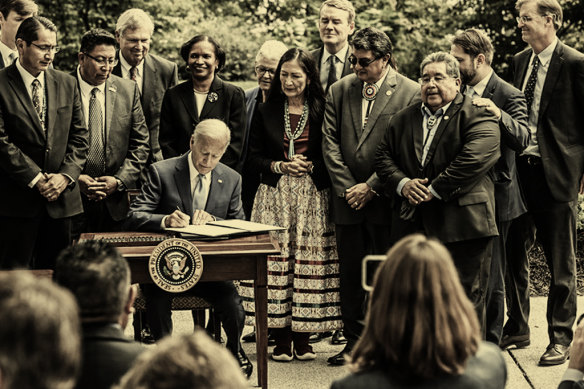
President Joe Biden signs proclamations expanding the areas of three national monuments in 2021.Credit: GETTY IMAGES, DIGITALLY TINTED
Could America ever become a dictatorship?
The classic dictator playbook is to manipulate an already unstable political environment and then either take over by force – military coup – or by confected popular demand, after which democratic structures and laws are rapidly dismantled. Idi Amin, one of the most corrupt, brutal and self-aggrandising dictators in recent history, is a textbook example. In 1971, after falling out with a prime minister who had sacked him as commander of the armed forces, he waited until his enemy was out of the country and then mobilised troops to seize the main airport, major roads and the national radio station. Amin told the populace he had done so merely to keep the peace while elections were called. But a week after the coup he declared himself president (and commander in chief of the armed forces), and appointed military leaders to top government posts. “There is freedom of speech, but I cannot guarantee freedom after speech,” he is reported to have once said.
The apocalyptic series The Last of Us portrays an America part-ruled by martial law after a pandemic.
The similarly reviled despot Francois Duvalier, also known as Papa Doc, was elected president of Haiti in 1957 but seized ultimate power after defeating a military coup against him in 1958 and employing emergency powers to suppress dissent. In the Philippines, former president Ferdinand Marcos placed the country under martial law in 1972 in response to possibly exaggerated threats from communists and other opposition groups.
In El Salvador, President Nayib Bukele has taken a subtler path, leveraging his popularity with everyday people (for brutally cracking down on gang warfare) while remaking aspects of the Supreme Court, the Office of the Attorney-General and how seats in parliament are allocated. He has openly fashioned the country into what has been dubbed the first “one-party state in a fully democratic system”.
In all of these examples, civil unrest, compromised judiciary, fragmented opposition parties and the threat of economic collapse typically preceded the use of extreme authoritarian powers. It has often been imagined in the US: Alex Garland’s recent film Civil War sets such a scene, with a maniacal president setting a country ablaze. The apocalyptic series The Last of Us portrays an America part-ruled by martial law after a pandemic.
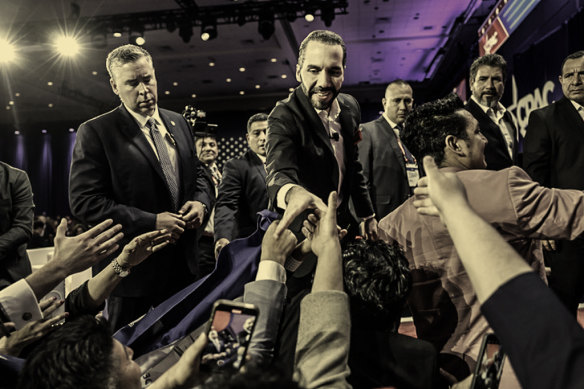
President Nayib Bukele has leveraged his popularity with everyday people.Credit: GETTY IMAGES, DIGITALLY TINTED
Hypothetically, then, it is possible to construct a path down which the United States similarly descends into dictatorship. In his essay for The Washington Post last year, Robert Kagan drew parallels between the state of American political parties and those in Germany’s Weimar Republic, the dysfunctional interwar state that gave rise to the Nazis. “German voters,” Kagan wrote, “increasingly yearned for someone to cut through it all and get something – anything – done. It didn’t matter who was behind the political paralysis, either, whether the intransigence came from the right or the left”.
He suggested that, once re-elected, Trump could ignore the courts, fill his administration with fellow travellers and use the FBI and sympathetic media to target and eliminate opponents. In the event people took to the streets, he said, they would be dealt with by invoking the Insurrection Act. Ultimately, “Should Trump be successful in launching a campaign of persecution and the opposition prove powerless to stop it, then the nation will have begun an irreversible descent into dictatorship.”
‘The Constitution is vague and ambiguous and potentially worrying when someone like Trump gets near to the centre of power.’
Alan Rozenshtein is more optimistic. He tells us that US institutions are stronger than in countries that have typically proved vulnerable to authoritarianism in recent history. “While the president has a lot of powers, at the end of the day, it’s just one person who’s issuing commands to lots of other people who issue commands to lots of other people. It’s a complicated system, and America is quite decentralised,” he says. “Turning an extremely well-established democracy into a dictatorship, especially one with such decentralised governing institutions, is like trying to turn an aircraft carrier with three oars; you can do it, but it’ll take a long time.”
John Hart concedes a dictatorship in the United States is “virtually” possible but only if all the checks and balances fail. Still, he says, “The Constitution is vague and ambiguous and potentially worrying when someone like Trump gets near to the centre of power.”
The Supreme Court is one check on the president’s power. However, since 2020, it has held a conservative majority, including three Trump–appointed justices. Impeachment is the only constitutional mechanism for holding the president accountable. But because it is a political mechanism, not a judicial one, it can succeed only when the political makeup of Congress is favourable, says Hart. Trump was the first US president to be impeached twice. But while the House of Representatives voted to charge Trump, in both cases the Senate acquitted him.
When Trump says he’ll be dictator for a day, it makes Rozenshtein think of the Roman Cincinnatus who, as legend has it, served as a temporary dictator to ward off two threats to the Roman Republic. But there’s a key difference. “He then immediately devolves his power and goes to become a farmer for the rest of his life,” Rozenshtein says. “It’s this incredible image that has gone through history – George Washington was thought of in the same way – and Trump is not Cincinnatus.”
This Explainer was first published in June and has since been updated to reflect Trump’s election to president in November 2024.
Get fascinating insights and explanations on the world’s most perplexing topics. Sign up for our weekly Explainer newsletter.
Let us explain
If you'd like some expert background on an issue or a news event, drop us a line at explainers@smh.com.au or explainers@theage.com.au. Read more explainers here.